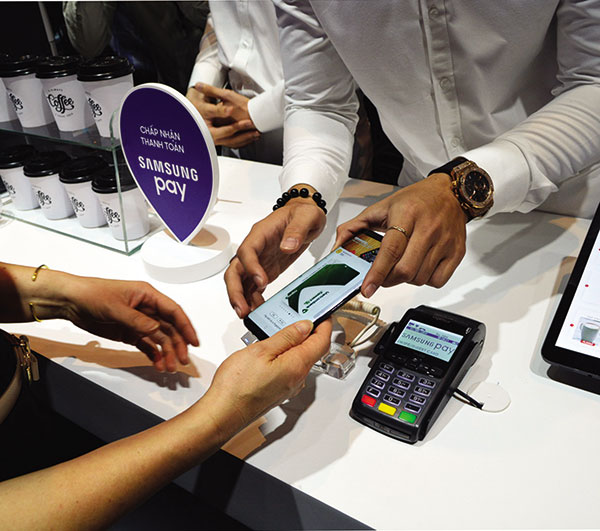Mobile pay: the great potential, and pitfalls
 |
| Lack of a common payment app standard is holding the format back, Photo: Le Toan |
Chinese financial services giant Alipay is soon expected to make its debut in Vietnam through the acquisition of leading Vietnamese fintech firms.
Nguyen Dang Hung, deputy general director of the National Payment Corporation of Vietnam (Napas), forecasts that by 2020, Vietnam will shift to chip card technology, and major global players like Samsung Pay, Apple Pay, and Google Pay might make forays into the country.
Samsung Pay is South Korea’s most favoured mobile payment service, officially deployed in Vietnam in late September last year.
In addition to these multinational giants, local banks and fintech firms have been racing to roll out digital payment systems.
Currently, the country is home to 25 “digital wallets”, and QR code payment methods have been deployed by 12 Vietnamese banks.
Many expected that the entrance of global mobile payment services in Vietnam would create a mobile payment boom across the country, but the reality has proven to be more complicated.
“Mobile payment apps are booming in Vietnam, with the strong presence of apps like mPos, QR Pay, digital wallets, and contactless payment services such as Samsung Pay. But, these services remain mere novelties, and none has gained popular acceptance,” banking expert Can Van Luc commented.
The booming presence of mobile payment apps has put Vietnam into a similar situation as Indonesia, where many digital wallets co-exist, but no single one has reached dominance. This is a problem because different stores may use different payment apps, making it impossible for consumers to use one app at any store.
In addition, the QR code method has yet to be standardised, and to use it, shops need to create different QR codes for every product, which takes time.
Hence, while mobile payment apps have seen booming development on the part of service providers, actual mobile payment market share remains marginal.
According to experts, Alipay could create a revolution in China due to its market hegemony, whereas in Vietnam, the myriad, non-standardised, payment app options create inconsistencies and compatibility issues within the market.
Tran Cong Quynh Lan, deputy general director at state-owned VietinBank, said that Vietnam has great potential for mobile payment services.
In the first nine months of 2017, QR code payment jumped 120 per cent, with about 5,000 stores currently accepting QR code payments, and 50,000 stores anticipated to be using the method by late 2018.
To turn QR Pay into a leading payment channel, a unified QR code format for mobile payment must be agreed upon, preventing the need to download different apps for different stores.
Luc believed that if payment tools do not follow common standards, many obstacles will arise and an integrated and market-wide mobile payment system cannot exist.
“Regarding QR code payment alone, businesses have presented different payment tools carrying diverse operating principles. The customers of a particular QR code system could make payment through that system only, causing market division and inconveniences to users,” Luc said.
Responsive to proposals from businesses, the State Bank of Vietnam’s Deputy Governor Nguyen Kim Anh said that as mobile payments grow more indispensable, the central bank is in the process of perfecting the relevant regulatory framework, striving to present common standards for mobile payments.
What the stars mean:
★ Poor ★ ★ Promising ★★★ Good ★★★★ Very good ★★★★★ Exceptional
Latest News
More News
- Securing capital and efficiency for Vietnam’s 2026-2030 growth ambitions (December 17, 2025 | 10:00)
- Energy sector in need of blended finance mechanisms (December 17, 2025 | 09:00)
- Vietnam still has room to mobilise capital for sustainable growth (December 17, 2025 | 08:57)
- Long-term capital seen as key hurdle to green growth (December 16, 2025 | 08:00)
- Gold prices swing amid tax debate and import uncertainty (December 15, 2025 | 18:04)
- Agribank frames bank credit as catalyst for green growth (December 15, 2025 | 17:59)
- Vietnam’s green transition demands collective financial action (December 15, 2025 | 12:00)
- VIR workshop highlights capital and policy for sustainable development (December 15, 2025 | 11:00)
- Promoting digital assets initiative in Vietnam (December 13, 2025 | 09:30)
- Experts flag gaps as national financial strategy under review (December 12, 2025 | 15:13)

















 Mobile Version
Mobile Version